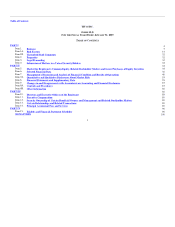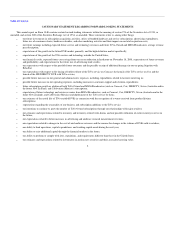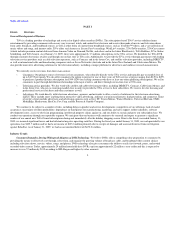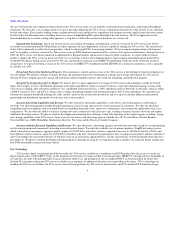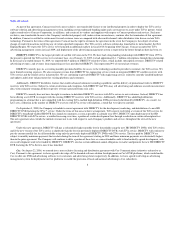TiVo 2008 Annual Report Download - page 14
Download and view the complete annual report
Please find page 14 of the 2008 TiVo annual report below. You can navigate through the pages in the report by either clicking on the pages listed below, or by using the keyword search tool below to find specific information within the annual report.
Table of Contents
• Standalone DVRs and hard drive-equipped DVD recorders, TVs, and game consoles: Several consumer electronics companies, including
Panasonic and Sony, produce DVD recorders with hard drives. In addition, several consumer electronics companies have television products that
are internet enabled, allowing them to access content and applications from various sources. Some of these TVs offer CableCARD functionality,
allowing the receipt of encrypted digital cable programming without the need for a digital cable set-top box. In general, these hard-drive equipped
DVD recorders and TVs do not require DVR service fees and offer basic DVR functionality. In the future, companies such as Sony and
Microsoft could incorporate DVR technology into their video game consoles, and Microsoft has now enabled the digital delivery of video
programming over the internet to its game console.
• Personal computers with DVR software: Microsoft's Windows XP Media Center and Vista Editions contain expanded digital media features
including enhanced DVR functionality. PC manufacturers including Dell and Hewlett Packard offer PCs running this Microsoft software and
other PC manufacturers such as Apple Computer may offer similar functionality in the future. Additionally, software programs such as MythTV
and SnapStream can be loaded onto a personal computer to provide enhanced DVR functionality. TiVo does offer a software-only version of the
TiVo Service called Nero LiquidTVTM | TiVo PC.
Licensing Competitors. Our licensing revenues depend upon both our ability to successfully negotiate licensing agreements with our consumer
electronics and service provider customers and, in turn, upon our customers' successful commercialization of their underlying products. In addition, we face
competition from companies such as Microsoft, Gemstar, OpenTV, NDS, D&M Holdings, Digeo, Gotuit, and 2Wire, which have created competing digital
video recording technologies. Such companies may offer more economically attractive licensing agreements to service providers and manufacturers of DVRs.
Established Competition for Advertising Budgets. Digital video recorder services, in general, and TiVo, specifically, compete with other advertising
media such as print, radio, television, Video on Demand, internet, and other emerging advertising platforms for a share of advertisers' total advertising
budgets. If advertisers do not perceive digital video recording services, in general, and TiVo specifically, as an effective advertising medium, they may be
reluctant to advertise on the TiVo service. In addition, advertisers may not support or embrace the TiVo technology due to a belief that our technology's
ability to fast-forward through commercials will reduce the effectiveness of general television advertising.
Audience Research Competitors. We compete with advertising research companies such as Nielsen, TNS, and RenTrak for research spend from
advertisers, advertising agencies, and television networks. These companies have all announced intentions to provide second-by-second viewership
information based on data from digital cable set-top-boxes and satellite set-top-boxes. The type of research we provide is a discretionary purchase. If
advertisers, advertising agencies, and television networks perceive the information provided by these companies to be more valuable, they may invest in those
services rather than ours, or they may choose not to purchase this type of information at all.
Patents and Intellectual Property
We have filed patent applications relating to many critical aspects of the design, functionality, and operation of TiVo products and services. We have
been awarded approximately 146 foreign and domestic patents and have approximately 251 foreign and domestic patent applications pending. We have also
filed patent applications related to technology that we may incorporate in future versions of our products and services. Patents we hold the rights to include:
• U.S. patent number 6,327,418, entitled Method and Apparatus Implementing Random Access and Time-Based Functions on a Continuous Stream
of Formatted Digital Data, originally filed on April 3, 1998, which describes a method of controlling streaming media in a digital device,
including the functions that enable DVRs to pause live TV as well as rewind, fast-forward, play, play faster, play slower, and play in reverse
television signals cached by the DVR. We refer to this as the "TrickPlay" patent. The expiration date of the TrickPlay patent is April 3, 2018.
• U.S. patent number 6,792,195 entitled Method and Apparatus Implementing Random Access and Time-Based Functions on a Continuous Stream
of Formatted Digital Data, which is a continuation of the TrickPlay patent. The expiration date of this patent is likewise April 3, 2018.
• U.S. patent 6,233,389, entitled Multimedia Time Warping System, originally filed on July 30, 1998, which describes many of the key inventions
associated with the TiVo-enabled DVR software and hardware design. We refer to this as the "TimeWarp" patent. Key inventions claimed in the
patent include a method for recording one program while playing back another or watching a program as it is recording, often referred to as time-
shifting the program; a method for efficient and low-cost processing and synchronizing of the various multimedia streams in a television signal
such as video, audio, and closed-captioning, and a storage format that easily supports advanced TrickPlay capabilities. The expiration date of the
TimeWarp patent is July 30, 2018.
11


